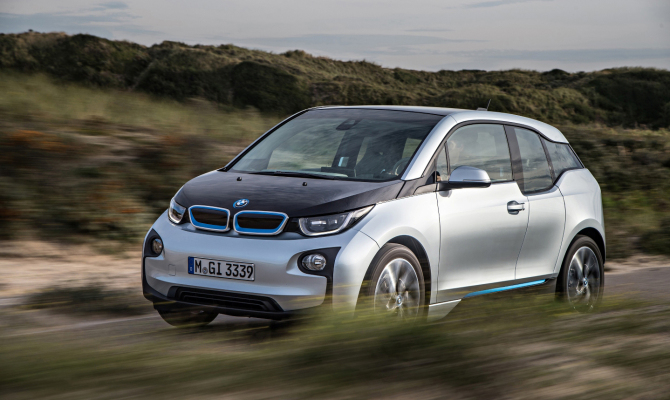“Customers may not have asked for an aluminum body, instead of steel, but there’s solid reasoning behind this change…”
Steel is out and aluminum is the new lightweight “in” material for auto body panels.
Hang on a minute, maybe it’s Carbon Fibre-Reinforced Plastic? These two materials, plus a very different type of hybrid, are entries for the 2015 AJAC Best New Innovative Auto Technology Award.
Ford – F150 Aluminum Body
“If I had asked people what they wanted, they would have said faster horses,” is a quote attributed to Henry Ford, founder of the Ford Motor Company.
The Ford F150 has been the best-selling in truck sold in Canada for the last four years. Customers may not have asked for an aluminum body, instead of steel, but there’s solid reasoning behind this change.
Aluminum reduces body weight by 40-to-50 per cent. It’s more resistant to corrosion issues and it’s 100 per cent recyclable. In addition to fuel efficiency benefits, a lighter vehicle also has positive influences on braking, handling, ride and acceleration.
A special heat treatment, developed by Ford, nearly doubles (compared to steel) the strength of the military grade aluminum (magnesium) alloy body panels used in the new F150, making them more resistant to dents. Much of the raw aluminum also comes from Canada, as does a good portion of the secondary processing.
Ford’s experience with aluminum body parts actually goes all the way back to the 1915 Model T. In 2009 it secretly built an aluminum body F150, for test purposes, and Ford engineers have also been able to draw from experience in developing current production vehicles such as the all-aluminum body Jaguar XJ.
BMW Carbon Fibre-Reinforced Plastic
The BMW i3 and i8 are two new all-electric vehicles with ultra-light-weight bodies made from Carbon Fibre-Reinforced Plastic (CFRP). It’s a man-made material that’s extremely strong and it’s about 30 per cent lighter than aluminum. This is the first time that the entire body of a production car has been made with a carbon fiber compound.
CFRP is a composite material consisting of carbon fiber surrounded by a plastic matrix (resin). It’s completely resistant to corrosion and is expected to have a substantially longer useful life than metal. It also remains stable under all climatic conditions, according to BMW, even when it’s exposed to large temperature fluctuations.
Carbon Fiber is not a new material to auto racing enthusiasts, where its exceptional strength and light weight make if an ideal body material. CFRP has also been used to make trunk lids, roofs and even drive-shafts in the sporty M Series models by BMW. The main drawback to using carbon fiber in mainstream production vehicles, however, has been its cost, which brings up a Pacific Northwest connection,
All of the carbon fiber use in i3 and i8 comes from a new production plant in Moses Lake, Washington State. In fact, BMW has plans to triple capacity in Moses Lake and make it the world’s largest carbon fiber production plant. More and more BMW models are expected to include components made with CFRP and large-scale production is expected to reduce unit costs.
Honda/Acura – Sport Hybrid SH-AWD
The hybrid edition of the new Acura RLX includes the first-ever electronic (torque vectoring) Super Handling All-Wheel Drive (SH-AWD) system used in a production hybrid vehicle. This RLX is also the most powerful Acura production model ever built. Combined peak output is 377 horsepower and peak torque to the front wheels is 273 lb-ft at 4,700 rpm. Yet, its fuel consumption is incredibly low, at just 8.0/ 7.5/ 7.7 L/100km (city/highway/combined).
The hybrid powertrain includes three electric motors, one up front and two in the rear, and they all provide both power assist and regenerative charge to a battery pack. The gas engine is a 3.5-litre, 310-horsepower V6 with Variable Cylinder Management that’s linked with the 7-speed dual-clutch transmission.
Acura’s super-handling all-wheel-drive uses “torque vectoring” to create a yaw moment that helps the RLX turn effortlessly. It functions like an enhanced differential that sends more power to the outside rear wheel during cornering. And, like magic, you’re a much better and smoother driver. The RLX’s sophisticated hybrid system can also allows it run strictly on battery power with the rear motors driving the vehicle.
The 2015 AJAC Best New Auto Safety Technology Award will be announced at the Montreal Auto Show on January 15, 2015.
Recent Comments
- { Enjoyed your Forest of Bowland in the BMW X5M, particularly the photo of the BMW in front of the main part of Stonyhurst College where... }
- { Bantam designed the Jeep, not Willy's or Ford. The American military gave the original Bantam prototype to Willys and Ford to copy. There is plenty... }
- { All Escalades come with a 6.2-lilter V8 engine that produces 420 horsepower. A six-speed automatic is the only transmission offered and drives the rear wheels.... }
- { Alexandra is an excellent journalist. }
Popular Posts
- Journey to a ‘Sparkling’ Luxury Okanagan Resort “Four lucky readers will put a Dodge Journey’s weekend-...
- The Need For Speed: Hike Those Highway Limits More than half of those polled believe the province sho...
- Drives-U-Crazy… Erratic drivers. An early morning drive from Kelowna to Vancouver is nor...
- Readers Respond: The Pros and Cons of Increasing B.C. Speed Limits Increasing the speed limits will only increase risk to...
- Honda CR-V Review: The Compact Crossover To Get Things Done The CRV is a very stylish and aerodynamic crossover veh...







